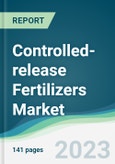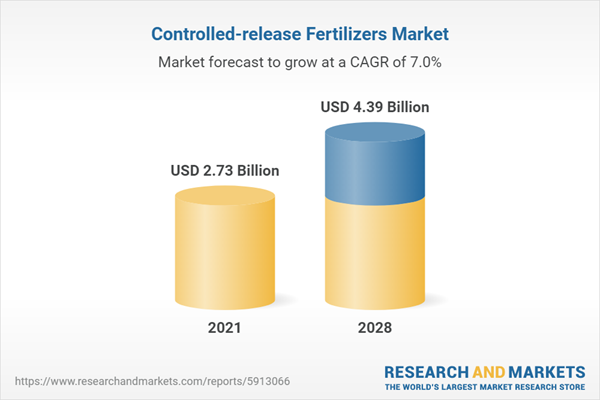The controlled-release fertilizers market was valued at US$2.73 billion in 2021 and is expected to grow at a CAGR of 7.02% during the forecast period.
A controlled-release fertilizer (CRF) is a granular fertilizer that slowly distributes nutrients into the soil over a specific length of time. Fertilizers with a regulated release can also be referred to as slow-acting fertilizer, delayed-release fertilizer, metered-release fertilizer, or fertilizer with a controlled availability.Conventional fertilizerrelease techniques not only result in a 50% loss of fertilizer due to seepage into the soil and water, but they also raise labour expenses. Agricultural applications, grass & turf, fruits & vegetables, nurseries, and gardens are just a few of the areas where controlled-release fertilizers are typically employed as specialised fertilizers.
Types of controlled-release fertilizers
The controlled-release fertilizer industry is divided into three types based on type: slow-release fertilizers, coated fertilizers, and nitrogen stabilisers. Slow-release fertilizers (crotonylidenediurea) are further divided into urea-formaldehyde, urea-isobutyraldehyde, and urea-acetaldehyde. Coated and nitrogen stabilisers are further divided into coatings made of sulphate, polymers, sulfate-polymers, and other materials. While stabilisers and inhibitors account for the majority of the market, CRFs and SRFs are utilised in considerably lesser quantities and may be regarded as a speciality.Agricultural sector to experience significant growth
The need for regulated and slow-release fertilizers will thus be dominated by the agricultural sector. Demand for these slow and controlled-release fertilizers is anticipated to increase throughout the forecast period as investments in sustainable and environmentally friendly fertilizers rise. Controlled-release fertilizer is a cutting-edge method that prolongs the period until nutrients are released by 3, 6, or even 15 months.The slow and controlled-release fertilizer market is anticipated to grow due to growing population, less arable lands and the need for more agricultural goods.
Growing adoption of modern agriculture practices
The market for controlled-release fertilizers is expanding rapidly due to the rising use of advanced agricultural techniques. The 4-R approach - applying the appropriate quantity of fertilizer to the right plant at the right stage of growth - is examined in controlled-release fertilizers, which are fertilizers that are released gradually over time.For instance, a report released in July 2022 by Khulna University Studies, a research and academic organisation located in Bangladesh, found that the farmers in the survey had been farming for an average of more than 23 years. The survey's findings show that 87 per cent of agricultural households in the study region manage irrigation, utilise superior seeds, and apply chemical fertilizers using contemporary technology. In 2023, almost 60% of individuals use technology for harvesting. Therefore, the controlled-release fertilizers market is anticipated to develop as contemporary agriculture practices are more used.
Technological advancement is growing
The controlled-release fertilizers industry is seeing a significant increase in a major trend called technological development. To improve their position, major players in the controlled-release fertilizer market are concentrating on creating cutting-edge products. For instance, in January 2022, Israel-based ICL Group announced the sixth iteration of their Osmocote controlled-release fertilizer. Osmocote 5 includes an enhanced Optimised Trace Element Availability (OTEA) system and a unique nutrient-matching release technology that fits the demands of plants throughout the release programme, leading to improved plant health, colour, and growth. Osmocote 5 has a little higher nitrogen concentration than Osmocote 4 to promote growth given the propensity to reduce or remove peat.Research and development to propel the market
In October 2022, a research team associated with the Laboratory of Polymeric Materials and Biosorbents at the Federal University of So Carlos (UFSCar) in Araras, So Paulo state, Brazil, has created and is testing cellulose-based materials for enhanced-efficiency fertilizers and slow and delayed release fertilizers to increase the supply of nutrients to crops and decrease the release of non-biodegradable chemicals into the environment.Growth in government initiatives
Concerning the use of controlled-release fertilizers, the European Union (EU) has passed several rules, including those controlling pesticide residue limits, nutrient management techniques, and environmental protection measures. India developed the Fertilizer Control Order, which establishes requirements for fertilizer manufacture, quality assurance, and labelling, especially for fertilizers including controlled-release fertilizers.Regulations for the safe handling, storage, and application of pesticides, particularly those containing slow and controlled-release fertilizers, are outlined in the FAO's International Code of Conduct on Distribution and Use of Pesticides. These rules are made to make sure that any potential environmental effects of these items are kept to a minimum.
Asia Pacific is projected to be the prominent market shareholder
The Asia-Pacific region leads the market for controlled-release fertilizers, due to the increase in the area of agricultural land under cultivation in developing nations. The government's attempts to promote farmer awareness will also help the controlled-release fertilizer market in the region flourish throughout the projection period.Asia Pacific countries impacted by technological advancements
A high degree of technical improvements in the agriculture sector, notably in nations like Japan, India, and China, is expected to make the Asia Pacific the fastest-growing region for the market for controlled-release fertilizers throughout the forecast period. Over the foreseeable future, Japan is anticipated to become a major consumer market for delay-release fertilizers and slow-release fertilizers. This is anticipated to increase the demand for controlled-release fertilizers in the area. Another element expected to fuel the spread of controlled-release fertilizers in Japan is the excellent results these fertilizers have on rice harvests.North America is the second-largest market shareholder
The International Fertilizer Association (IFA) estimated that by 2022, the world's demand for urea rose by 1.6% annually, reaching 188 million metric tonnes, while the supply (effective capacity) reached 197 million metric tonnes. North America has emerged as one of the most prospective nitrogen investment regions and is one of the top suppliers of nitrogen fertilizers worldwide, owing to the growth of the controlled-release fertilizers market.Market Key Developments
- In September 2022, Polyfeed Osmo is a brand-new delay-release fertilizer that was introduced by Israel Chemicals Ltd. The product, which is intended for use in horticulture, releases nutrients gradually over 4-6 months.
- In February 2022, ICL offered fertilizers for lawn care that either included resin-coated nitrogen coupled with phosphate and potash (PACE) or urea coated with nitrogen, sulphur, and a biodegradable polymer membrane (Poly-S). This prevents unchecked shock development, which requires less work while mowing.
- In March 2022, the Brazilian distributor Fertilizantes Heringer SA's shareholding control was acquired by EuroChem Group, with 51.48% of the shares, further enhancing its manufacturing and distribution capabilities there.
Segmentation:
By Type
- Slow Release
- Nitrogen stabilizers
- Coated and encapsulated
By Mode of Application
- Foliar
- Fertigation
- Soil
- Others
By End Use
- Agricultural
- Cereals and grains
- Oilseed and pulses
- Fruits and Vegetables
- Others
- Non-agricultural
By Geography
- North America
- United States
- Canada
- Mexico
- South America
- Brazil
- Argentina
- Others
- Europe
- United Kingdom
- Germany
- France
- Spain
- Others
- Middle East and Africa
- Saudi Arabia
- UAE
- Israel
- Others
- Asia Pacific
- Japan
- China
- India
- South Korea
- Indonesia
- Thailand
- Others
Table of Contents
1. INTRODUCTION
2. RESEARCH METHODOLOGY
3. EXECUTIVE SUMMARY
4. MARKET DYNAMICS
5. CONTROLLED-RELEASE FERTILIZERS MARKET, BY TYPE
6. CONTROLLED-RELEASE FERTILIZERS MARKET, BY MODE OF APPLICATION
7. CONTROLLED-RELEASE FERTILIZERS MARKET, BY END-USE
8. CONTROLLED-RELEASE FERTILIZERS MARKET, BY GEOGRAPHY
9. COMPETITIVE ENVIRONMENT AND ANALYSIS
10. COMPANY PROFILES
Companies Mentioned
- Haifa Group
- Helena Agri-Enterprises LLC
- Israel Chemicals Ltd.
- Koch Industries Inc.
- Nufarm Ltd.
- Nutrien Ltd.
- Sociedad Quimica y Minera de Chile SA
- Sumitomo Chemical Co. Ltd.
- Yara International ASA
Methodology

LOADING...
Table Information
| Report Attribute | Details |
|---|---|
| No. of Pages | 141 |
| Published | October 2023 |
| Forecast Period | 2021 - 2028 |
| Estimated Market Value ( USD | $ 2.73 Billion |
| Forecasted Market Value ( USD | $ 4.39 Billion |
| Compound Annual Growth Rate | 7.0% |
| Regions Covered | Global |
| No. of Companies Mentioned | 9 |









